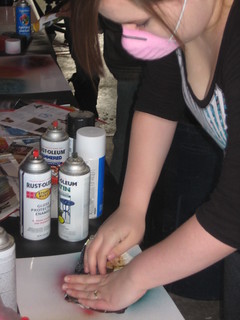Safety Check: which face masks should I use for home DIY?
Summer is here and home-improvement is in high gear. But did you know that health officials recommend using particulate respirators during many basic home DIY projects? These masks cost less than $10 and offer protection against airborne particles that can contribute to immediate and long-term health problems – especially if you are prone to allergies or asthma.
Here’s a rundown of the most common respirator types, and when to use them.
N95 masks
These masks are the most “basic” particulate respirators, but can do a world of good. Make sure that any respirator you choose is approved by the National Institute for Occupational Safety and Health (NIOSH). Approved products will be marked with a symbol, such as “N95.” This indicates that the mask is not (“N”) resistant to oil, but filters at least 95 percent of solid- and liquid-based airborne particulates, found in:
Dust: If you’re sanding a wall or furniture piece, a N95 mask will protect you from inhaling dust, which may contain lead from lead-based paint. Indoor cleaning can also kick up dust particles, so the Asthma and Allergy Foundation of America recommends reducing symptoms by wearing a mask while dusting, sweeping or vacuuming.
Fiberglass insulation: N95 masks also protects against fiberglass wool. While the International Agency for Research on Cancer (IARC) has removed glass wool from its list of carcinogens, the fibers still can cause respiratory irritation.
Cement: Cement contains crystalline silica, which can cause scarring of the lungs, an increased risk of tuberculosis, kidney disorders, and even cancer. To protect against respirable crystalline silica, the NIOSH recommends using a N95 particulate respirator.
Water-based paint: Even water-based paints can contain crystalline silica, so it’s important to take precautions, especially if you will be using a paint sprayer.
The great outdoors: While you mow the grass or garden, N95 masks can protect against pollen and other outdoor allergens.
R95 masks
NIOSH-certified R95 masks protect against 95 percent of solid- and liquid-based particulates, but are also resistant (“R”) to oil and can protect against non-hazardous household odors. It’s important to note that they are only rated effective for eight hours of use.
Latex paint: R95 masks with a carbon layer reduce the “nuisance” odors associated with latex painting.
OV/P100 masks
This NIOSH code indicates that a mask protects against 100 percent of particulates and organic vapors (“OV”), and is oil-proof (“P”).
Pesticides: Particularly if you’re applying pesticides in a space that isn’t well-ventilated – say, in a closet, use a OV/P100 mask to protect yourself against chemicals that can cause nose, throat and lung irritation.
Oil-based paint: These masks can also protect against solvents found in oil-based paint and some paint strippers, which can have toxic effects on the nervous system and could increase the risk of cancer.
With any household product, make sure to fully read the label for the manufacturer’s precautions.
Category: DIY Safety, Safety Tips













